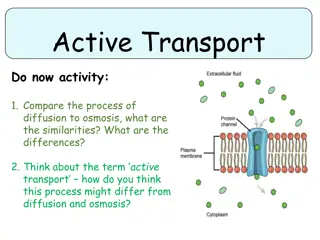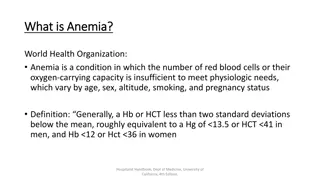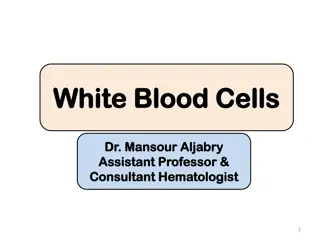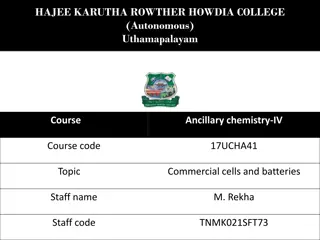Understanding Blood Cells and Transport Mechanisms
Your blood, consisting of red blood cells, white blood cells, platelets, and plasma, plays a crucial role in transporting substances like oxygen, nutrients, and waste products throughout your body. Red blood cells are specialized for oxygen transport due to their unique adaptations, while white blood cells help fight off infections. Platelets are essential for clotting to prevent excessive blood loss. This informative content explores the structure and functions of different blood cells and the mechanisms involved in substance transportation within the body.
Download Presentation

Please find below an Image/Link to download the presentation.
The content on the website is provided AS IS for your information and personal use only. It may not be sold, licensed, or shared on other websites without obtaining consent from the author. Download presentation by click this link. If you encounter any issues during the download, it is possible that the publisher has removed the file from their server.
E N D
Presentation Transcript
The blood Do Now activity: 1. How is a red blood cell adapted to carry out its function? 2. Apart from red blood cells, can you name any other examples of cells found in the blood? 3. How are substances transported around the body?
Progress indicators GOOD PROGRESS: - Identify pictures representing the different types of blood cells - Describe the four main components of blood OUTSTANDING PROGRESS: - Explain how each component is adapted to it s function
Your blood is a unique tissue, based on a liquid called plasma. Plasma carries red blood cells, white blood cells and platelets suspended in it. It also carries many dissolved substances around your body.
Task: You are going to given a placemat of questions, you will need to fill this in using the slips of information you will get. Make sure you try and use as many of the key words as you can in your answers . Write in full sentences.
Blood plasma Red blood cells 1. List the substances that are carried around the body in the blood plasma. Carbon dioxide, urea, substances from digestion. E.g. glucose, amino acids, lipids 1. What is the job of the red blood cell? To carry oxygen from the lungs to respiring cells 2. List three adaptations of a red blood cell and explain how this helps a red blood cell to do it s job Biconcave shape higher SA:Vol ratio = faster diffusion Lots of haemoglobin to bind to more oxygen No nucleus more space for haemoglobin to carry more oxygen 2. Where is urea formed and where does it exit the body? Forms in the liver and is removed from the body by the kidneys EXTRA CHALLENGE: Why do you think that urea needs to be removed from the body? EXTRA CHALLENGE: Why do is it important that red blood cells have adaptations to do their job properly? What would happen if red blood cells couldn t carry oxygen around the body? Platelets White blood cells 1. Describe the structure of a platelet Small fragments of cells which do not have a nucleus 1. State one difference of a red blood cell to a white blood cell? A white blood cell is bigger and also has a nucleus 2. Describe how clotting helps to prevent blood loss Protein fibres will form a network with additional platelets to form a clot 2. How do white blood cells help to control microorganisms in the body? Produce antibodies kills microorganisms Produces antitoxins stops poisons from microorganisms Phagocytes engulf and break down microorganisms EXTRA CHALLENGE: If a scab did not form and bacteria entered into your blood stream, explain what might happen to the microorganism EXTRA CHALLENGE: Why is it important that your white blood cells have different ways of killing microorganisms? Self-assessment
Transporting oxygen Red blood cells carry oxygen. When a red blood cell passes through a capillary close to the alveolus in the lungs oxygen diffuses into the red blood cell. The oxygen combines with the haemoglobin to produce a bright red substance called oxyhaemoglobin.
Transporting oxygen When oxygenated blood flows through a capillary close to respiring cells, the oxygen leaves the oxyhaemoglobin and diffuses out of the blood and into the cells. The oxyhaemoglobin is split up into haemoglobin and oxygen and the blood becomes less bright red this is deoxygenated blood.
Task: Using the sentences below to complete the flow diagram to show how red blood cells transport oxygen around the body: The red blood cells return to the lungs to collect more oxygen. The blood is now oxygenated rich in oxygen. When oxygenated blood flows through a capillary close to respiring cells oxyhaemoglobin splits back into oxygen and haemoglobin. Oxygen combines with haemoglobin, forming oxyhaemoglobin. The blood is now deoxygenated. When a red blood cell passes through a capillary close to the alveolus oxygen diffuses into the red blood cell Oxygen diffuses out of the blood and into the tissue cells.
Self-assessment: 1. When a red blood cell passes through a capillary close to the alveolus oxygen diffuses into the red blood cell 2. Oxygen combines with haemoglobin, forming oxyhaemoglobin. 3. The blood is now oxygenated rich in oxygen. 4. When oxygenated blood flows through a capillary close to respiring cells oxyhaemoglobin splits back into oxygen and haemoglobin. 5. Oxygen diffuses out of the blood and into the tissue cells 6. The blood is now deoxygenated. 7. The red blood cells return to the lungs to collect more oxygen
True or False? When oxygen binds to haemoglobin within the red blood cells the blood is said to be deoxygenated FALSE Platelets are small fragments of cells with no nucleus TRUE Red blood cells do not contain a nucleus, this makes space for more haemoglobin meaning more oxygen can be transported TRUE White blood cells are needed to form scabs when you have a cut or a graze FALSE Blood plasma carries waste products such as carbon dioxide and urea TRUE
Task: Answer the past-paper question on your own at the back of your books! Exam-style question 6 = 6 minutes! 1. Complete the following table to give either the name or function of different components of blood: (3 marks) Blood component Function Red blood cell Help to clot the blood White blood cell 2. Explain how haemoglobin helps a red blood cell to pick up oxygen from the alveoli and release it to cells where it is needed in the body. (4 marks)
Self-assessment: 1. a) Function of red blood cell: to pick up oxygen from the lungs and carry it around the body in blood vessels, delivering it respiring cells. b) Blood component: Platelets c) Function of white blood cells: make antibodies/antitoxins, engulf or destroy bacteria 2. - Oxygen diffuses from the alveoli and into the bloodstream - Oxygen has an affinity for haemoglobin/forms oxy- haemoglobin - In areas of high oxygen concentration - Where there is a low oxygen concentration oxy- haemoglobin breaks down and release oxygen (e.g. to respiring tissues)
Plenary: Produce a brain storm of all the key words we have learnt so far that are associated with the blood! Blood Key Words
Blood plasma Red blood cells 1. List the substances that are carried around the body in the blood plasma. 1. What is the job of the red blood cell? 2. List three adaptations of a red blood cell and explain how this helps a red blood cell to do it s job 2. Where is urea formed and where does it exit the body? EXTRA CHALLENGE: Why do is it important that red blood cells have adaptations to do their job properly? What would happen if red blood cells couldn t carry oxygen around the body? EXTRA CHALLENGE: Why do you think that urea needs to be removed from the body? Platelets White blood cells 1. Describe the structure of a platelet 1. State one difference of a red blood cell to a white blood cell? 2. Describe how clotting helps to prevent blood loss 2. How do white blood cells help to control microorganisms in the body? EXTRA CHALLENGE: If a scab did not form and bacteria entered into your blood stream, explain what might happen to the microorganism EXTRA CHALLENGE: Why is it important that your white blood cells have different ways of killing microorganisms?
Blood plasma Blood plasma is a transport medium, it transports your blood cells and other substances around your body. Waste carbon dioxide produced by cells is carried to the lungs Urea formed in your liver from the breakdown of proteins is carried to your kidneys where it is removed as urine The small, insoluble products of digestion pass into the plasma and are carried to individual cells Red Blood Cells There are more red blood cells than any other cell in your body. The job of a red blood cell is to pick up oxygen from the air in your lungs and carry it to cells. Red blood cells have adaptations which make them efficient at their job: Biconcave shape means a high surface area to volume ratio, this increases diffusion Packed full of haemoglobin that binds to oxygen No nucleus = this means there is more space for haemoglobin
White blood cell White blood cells are much bigger than red blood cells and there are fewer of them. They have a nucleus and form part of the body s defence system. Different types of white blood cells do different things: Some produce antibodies to fight against microorganisms Some produce antitoxins to fight poisons made by microorganisms Phagocytes engulf and digest microorganisms Platelets These are small fragments of cells which have no nucleus. Their main job is to clot the blood. Clotting involves producing a network of protein fibres that capture red blood cells and more platelets to form a clot, so you don t bleed to death! The clot dries and hardens to form a scab, this stops bacteria entering the wound.























